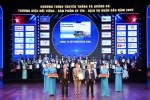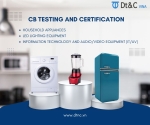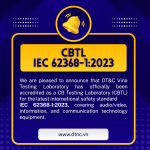The testing services of Dt&C VINA include:
- Radiated Emission (RE)
- Conducted Emission (CE)
- Magnetic Field Emission (MFE)
- Conducted Transient Emission (CTE (VTE))
- Bulk Current Injection (BCI)
- Magnetic Field Immunity (MFI)
- Conducted Transient Immunity (CTI)
- Electrostatic Discharge (ESD)
- Handy Transmitter
- E-Mark: ECE R-10.05, ECE R-97
- KC Mark: KN41
- ...
Some common testing standards
1. CISPR 25
CISPR 25 is an EMC standard for measuring radio interference characteristics to protect receivers used on vehicles with a frequency range of 150 kHz to 2 GHz. Vehicles include cars and boats powered by internal combustion engines. CISPR 25 also covers equipment powered by an internal combustion engine, but not necessarily intended for the transport of people, such as air compressors, d.c. generators, garden equipment, etc. components/modules in the same vehicle.
CISPR 25 consists of two parts, the first part covers the inspection of the entire vehicle or system, where the antenna mounted on the vehicle measures the noise generated by the different electrical and electronic systems of the same vehicle. Another part of the standard covers test methods for measuring interference from vehicle-independent components and modules. The standard also includes test chamber requirements necessary for vehicle radiation tests.
CISPR 25 has specified that the allowable electromagnetic noise level in the test area should be 6 dB below the lowest level measured. Such values can only be obtained if the test environment is free from external RF interference. An RF shielded room is therefore used to protect the equipment under test (EUT) from external RF signals such that the EUT will be the primary source of any radiated interference.
2. ISO 7637
ISO 7637 Road vehicles - Electrical disturbances from conduction and coupling is an international electromagnetically compatible vehicle standard developed by the International Organization for Standardization (ISO) announced, relating to 12 and 24V electrical systems.
The electrical disturbance standards include test methods for road vehicles that are exposed to a variety of possible sources of electrical noise. ISO standards from three sets, ISO 11452, ISO 11451 and ISO 7637, contribute greatly to this area of standardization. ISO 7637 deals specifically with conduction and coupling.
ISO 7637-1:2015 Road vehicles - Electrical disturbances from conduction and coupling - Part 1: Definitions and general considerations: The ISO 7637-1:2015 standard defines basic terms related to electrical disturbances due to conduction and coupling used in other parts of ISO 7637. This standard also gives general information about the entire ISO 7637 family of standards.
ISO 7637-2:2011 Road vehicles - Electrical disturbances from conduction and coupling - Part 2: Electrical transient conduction along supply lines only: The ISO 7637-2:2011 standard specifies test methods and procedures to ensure interoperability Suitable for electrical transients of equipment installed on passenger cars and commercial vehicles equipped with 12 V or 24 V electrical systems. It describes bench tests for both injection and transient measurement. . This standard is applicable to all types of road vehicles independent of propulsion (e.g. spark or diesel engines, electric motors). Functional performance state classification for immunity to transients is also provided.
ISO 7637-3:2016 Road vehicles - Electrical disturbances from conduction and coupling - Part 3: Electrical transient transmission by capacitive and inductive coupling via lines other than supply lines: The ISO 7637-3:2016 standard defines tape test methods bench to evaluate the immunity of the equipment under test (DUT) to transient impulses coupled to lines other than the supply line. The following three test methods are described in ISO 7637-3:2016: - capacitive coupling clamp method (CCC); - direct capacitive coupling (DCC) method; - inductive clamping method (ICC).
3. ISO 11452
ISO 11452 - Component Test Methods for Electrical Disturbances in Road Vehicles: determination of immunity of electronic components of passenger cars and commercial vehicles to electromagnetic disturbances from narrow band radiated electromagnetic energy, regardless of propulsion system of the vehicle (e.g. ignition engine, diesel engine, electric motor).
ISO 11452 - Methods for testing components for Electrical disturbances in road vehicles include:
- ISO 11452-1:2015
- ISO 11452-10:2009
- ISO 11452-11:2010
- ISO 11452-2:2019
- ISO 11452-3:2016
- ISO 11452-4:2020
- ISO 11452-5:2002
- ISO 11452-7:2003
- ISO 11452-7:2003/Amd1:2013
- ISO 11452-8:2015
Above is some basic information about Automotive EMC testing standards, for more detailed advice please contact email: info@dtnc.vn or hotline: 0862619168.









![[MIC] Officially issued QCVN 134:2024/BTTTT - National technical regulation on specific absorption levels for handheld and body-worn radio devices according to Circular 19/2024/TT-BTTTT of Ministry of Information and Communications](https://cdn0577.cdn4s.com/thumbs/qcvn-134_thumb_150.jpg)



![[Latest] Circular 02/2024/TT-BTTTT regulating the List of potentially unsafe products and goods under the management responsibility of the Ministry of Information and Communications](https://cdn0577.cdn4s.com/thumbs/trang-huy-hieu-the-loai-logo-2_thumb_150.jpg)